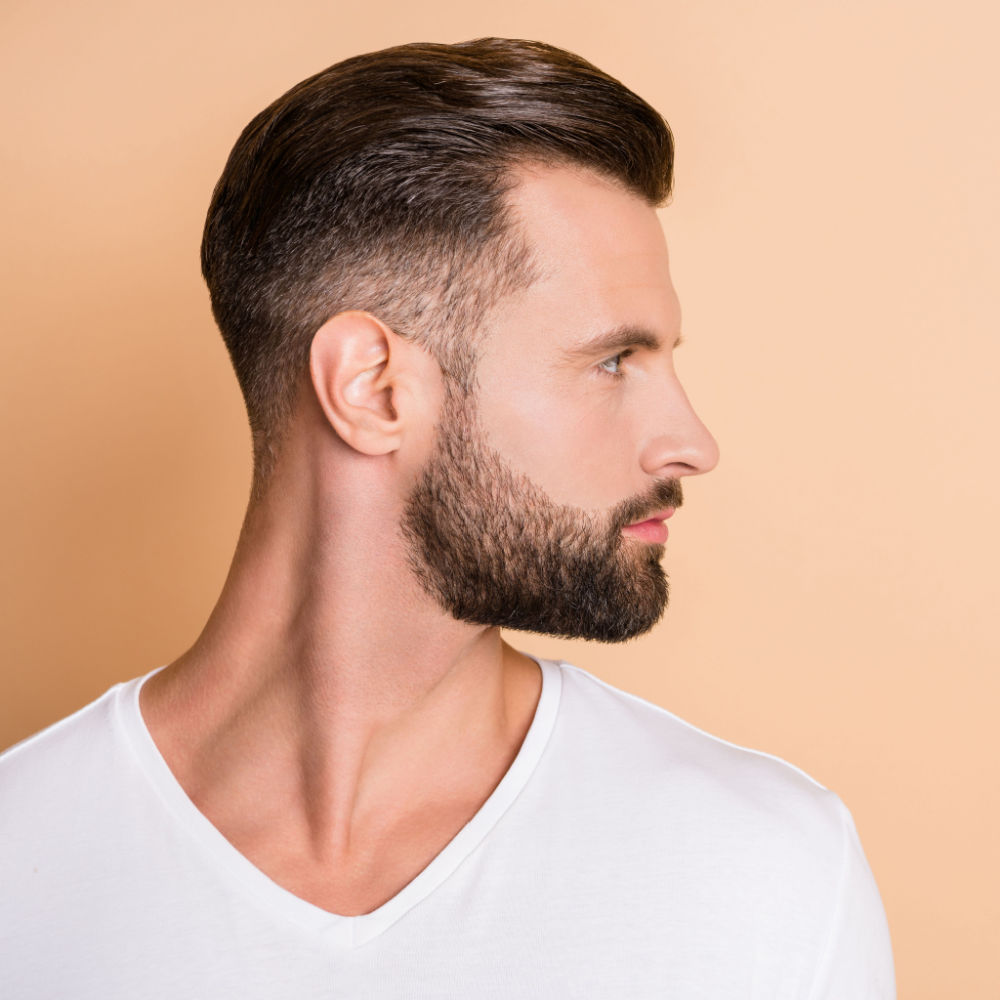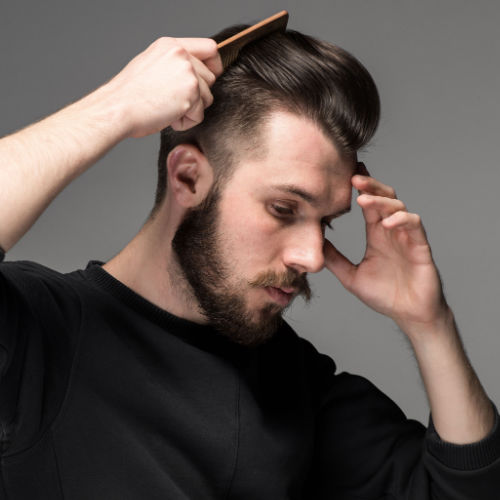Why Am I Losing My Hair?
On average, most people shed between 50 and 100 hairs per day as a result of brushing and washing their hair. These lost hairs are naturally replaced by new hair growth, so the loss isn’t usually noticeable.
However, if you observe thinning or patchy areas on your scalp or lose more than 100 hairs daily, it may be due to a hair loss condition. Some of the most common conditions that result in hair loss and balding include:
- Male pattern baldness
- Polycystic ovarian syndrome (PCOS)
- Thyroid disease
- Alopecia areata
- Stress
- Telogen effluvium (TE)
- Traction alopecia
- Lichen planus
- Lichen planopilaris
- Dermatitis
- Alopecia totalis
- Melanoma
- Auto-immune conditions
What Cosmetic Hair Restoration Treatments Are Available?
At our hair transplant center near Franklin Lakes, NJ, we offer treatments clinically proven to reliably and permanently restore hair growth—including a combination of surgical and non-surgical treatments, so you can choose the procedure that’s right for you.
Additionally, our team is comprised of board-certified cosmetic surgeons and hair transplant specialists with extensive experience performing the treatments we offer.
Medications That Promote Natural Hair Growth
Hair transplants are one of the most reliable ways to restore your natural hair growth. However, prescription medications may be a good alternative for those who don’t want surgery. Minoxidil (Rogaine) and Finasteride (Propecia or Proscar) are the two most common medications prescribed for hair loss.
Minoxidil is a topical treatment that you massage into balding areas to improve blood circulation under the skin and promote hair growth. Finasteride is a pill that you take orally to prevent the conversion of testosterone to dihydrotestosterone—a hormone that can cause male pattern baldness.
You must use both of these medications daily for them to work properly. If you stop using them, you’ll experience continued hair loss.
If you’re taking one of these medications, our hair transplant doctors in Franklin Lakes, NJ, can work with you to develop a supplementary treatment plan to help them work better. We also offer non-surgical hair restoration procedures like platelet therapy and PDO threads.
Hair Transplant Surgeries
Hair transplant surgeries may be a good hair restoration option for those who don’t want to take medication or use topical treatments indefinitely. Each of these treatments takes several hours (or less) to complete and typically produces permanent results.
Additionally, at the Hair Transplant Center – New Jersey in Franklin Lakes, NJ, our cosmetic surgeons only use proven treatments and the latest technology. When you receive hair loss treatments from us, you’re getting the best care available.
Follicular Unit Transplantation (FUT)
Sometimes called “hair plugs,” FUT is a surgical hair restoration procedure that involves taking a strip of healthy follicles from the back of your head and transplanting them into thinning or balding areas.
This hair transplant procedure is considered minimally invasive and uses local anesthesia to keep the patient comfortable. Most procedures take between four and eight hours.
Follicular Unit Extraction (FUE)
Also known as “hair implants,” FUE treatments involve transplanting healthy hair follicles from a donor area to a balding area. This hair transplant treatment doesn’t require incisions and is an outpatient procedure.
Facial Hair Transplants
A thinning beard, mustache, or eyebrows can disrupt your confidence just as much as a receding hairline. Our facial hair transplants can eliminate patchy areas and make your beard and eyebrows look full again.
Female Hair Restoration
Though hair loss is frequently associated with men, it can also affect women. At The Hair Transplant Center – New Jersey, we perform hair restoration treatments on people of all genders. Our technicians can help determine the cause of your hair loss and create a personalized treatment plan to restore it.
Cosmetic Hair Restoration Procedures
Platelet-Rich Plasma: PRP Therapy
PRP therapy uses a patient’s own biology to revive hair follicles and promote hair growth without surgery or transplantation. The procedure involves drawing a small amount of your blood and extracting platelet cells from it to create a rich serum. They then administer the platelets to your scalp using a microneedling tool.
Platelets contain a high concentration of nutrients that promote wound healing in the body. This same process works to reactivate your follicles and restore natural hair growth.
Scalp Micropigmentation (SMP)
Rather than stimulating hair regeneration, SMP simulates the appearance of real hair by tattooing fine, hairlike lines onto your scalp with a microneedling tool. This procedure works well for those with thinning hair, as the tattoos help simulate fullness.
SMP procedures take less than an hour and don’t require recovery time.
PDO Threads
PDO threading is a nonsurgical procedure using polydioxanone threads—the same threads used in medical sutures. These threads are inserted under the skin on the scalp to stimulate the production of collagen, elastin, fibroblasts, and anagens. All of these substances work together to reactivate and nourish your hair follicles to stimulate new hair growth.
Stem Cell Grafting
Stem cell grafts are similar to hair follicle transplants in that hair follicles are moved from one area of the body to the scalp. However, stem cell grafts use a small skin sample that contains healthy hair follicles. The follicles are harvested from the skin sample, replicated in a lab, and administered to the appropriate areas. The greatest advantage of this procedure is that it encourages hair growth in balding areas and in the donor area.
Though no recovery time is required after a stem cell graft, you may experience some pain after the procedure. It should be fairly mild and fade in a week. During this week, you should avoid strenuous activities and exercise.
This hair restoration procedure is performed under anesthesia, so you won’t feel pain or discomfort while the procedure is being done.

